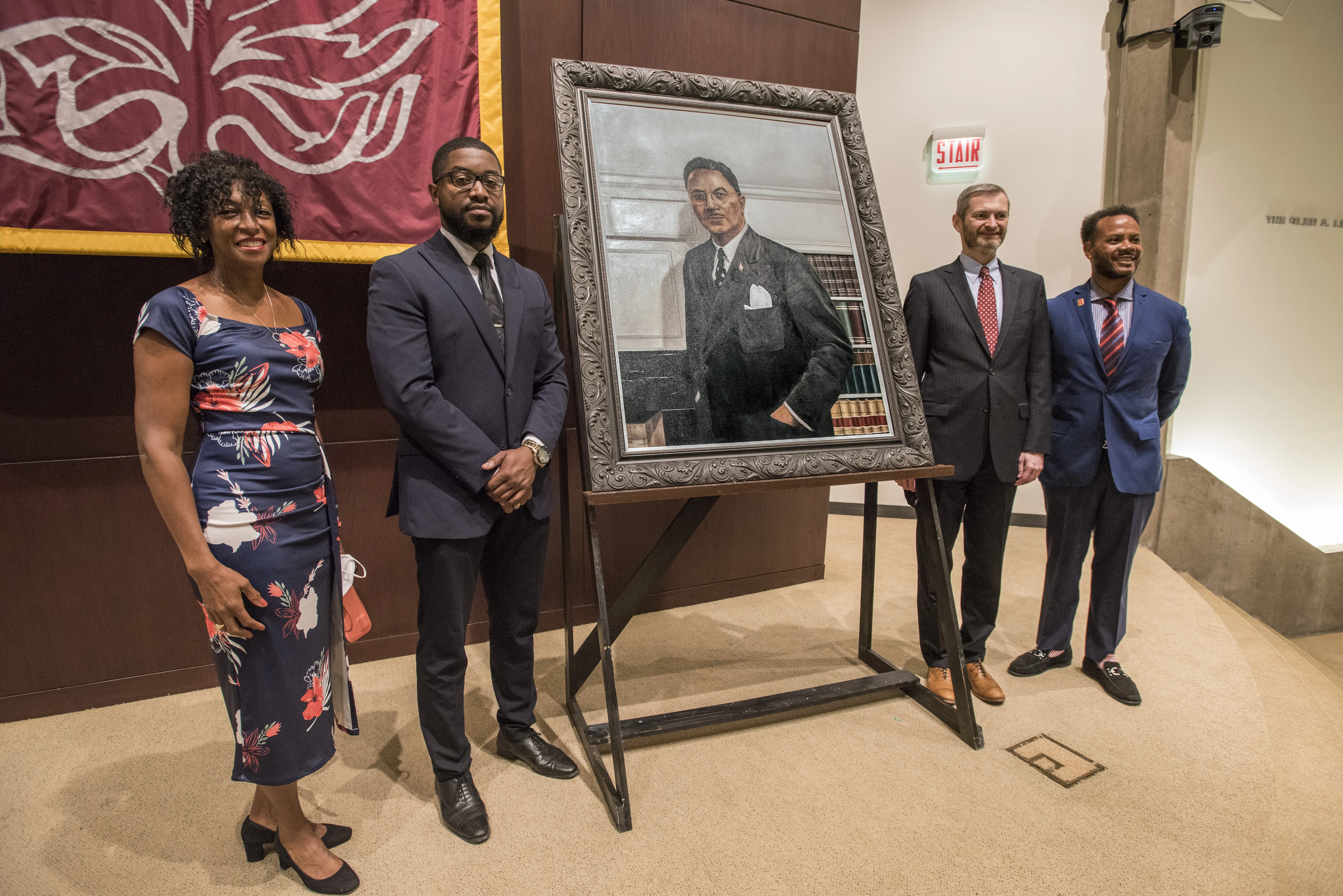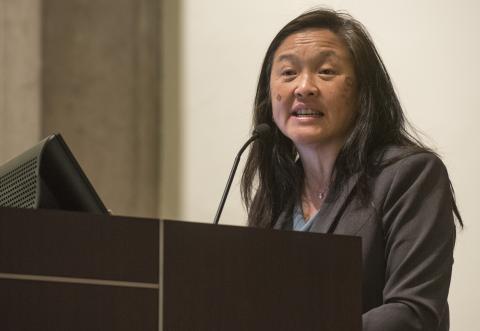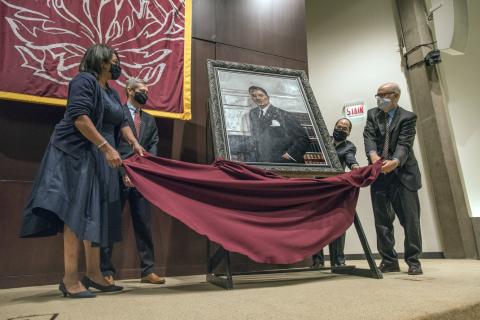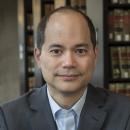Law School Unveils Oil Painting of Earl B. Dickerson, 1920, by Chicago Artist

When the University of Chicago Law School commissioned artist Shawn Michael Warren to paint a portrait of its first Black JD graduate, Warren turned first to a stack of reading and then began visiting the library. The story of Earl Burrus Dickerson, 1920, wasn’t immediately familiar; Dickerson, after all, is a local figure who was well-known in the early 20th century but whose remarkable life was never stamped into the collective memory.
But interpreting history and sharing stories about communities of color is Warren’s central artistic passion—it was a reason a local gallery recommended him to the Law School as perfect for the project. So, before long, Warren was steeped in the late Dickerson’s many accomplishments: a successful US Supreme Court argument that helped end racially restrictive covenants; roles on the national board of the NAACP, President Franklin D. Roosevelt’s Fair Employment Practices Committee, and the Chicago City Council; decades of leadership at a Chicago-based insurance company that expanded economic opportunities for African Americans; and more.
On Monday, Warren joined University of Chicago Provost Ka Yee C. Lee and Law School Dean Thomas J. Miles at a ceremony unveiling the 48” x 36” oil-on-canvas painting, which depicts a regal and stoic Dickerson standing before a white marble fireplace in his home office. Behind him are shelves lined with books. The event marked the finale in a year-long centennial celebration that included a two-part conference on Dickerson’s life and work, as well as other events aimed at exploring and highlighting his legacy.
“Mr. Dickerson paved the way for many other talented Black lawyers from historically underrepresented communities to attend the Law School … [and] his life and legacy have had a lasting impact on the Law School, its students, and alumni,” Lee told students, faculty, staff, and guests in the Law School auditorium. “The inclusion of his portrait in the halls of this building, next to portraits of renowned leaders of legal scholarship and teaching, is especially significant. This is the first portrait of an African American to be displayed in this building, and the first portrait of someone who did not teach at the Law School. This reflects the impact of Mr. Dickerson’s influence and signifies the University’s commitment to advancing his legacy.”
The portrait joins the Law School’s collection of other portraits, including renderings of Soia Menschikoff, Ernst Freund, Bernard Meltzer, Harry A. Kalven, Jr., James Parker Hall, and longtime Dean Edward Levi.
“Today, we take an important step in making our understanding of the history of our school fuller and, in so doing, making a better present and future,” said Dean Thomas J. Miles, the Clifton R. Musser Professor of Law and Economics. “Viewing the portrait should make us remember Mr. Dickerson’s courage in attending this Law School. It should strengthen our belief in the importance of the law and the legal system. It should remind us of the importance of ideas and thinking and learning deeply about law. Viewing it should inspire us as to what the legal system can accomplish, and to what our students can achieve with the education they receive here. As [historian and former University of Chicago professor] John Hope Franklin said, ‘Good history is a good foundation for a better present and future.’”
Warren—whose work includes a mural interpreting the 1921 Black Wall Street massacre in Tulsa, Oklahoma; an oil-on-linen portrait of Malcolm X; and a 300’ x 26’ West Loop mural featuring Oprah—said he hopes that his Dickerson portrait will bring “great honor to Mr. Dickerson, his legacy, his family, his fraternity, and this institution.”
Several members of Kappa Alpha Psi fraternity, which helped support the creation of the portrait, attended the event. Dickerson helped charter the fraternity’s Beta chapter at the University of Illinois, helped found the organization’s first alumni group, and later served as the historically Black fraternity’s grand polemarch, or national president.
“He was a big pillar in the Kappa Alpha Psi fraternity and is still quite revered and well respected,” Warren said.
Also attending the event were Andre and Frances Guichard, the owners of Gallery Guichard, a Bronzeville gallery that features multicultural artists specializing in the art of the African diaspora and emerging and underrepresented artists. They recommended Warren to paint the Dickerson portrait.
As he introduced Warren, Andre Guichard, a member of Kappa Alpha Psi, noted that their first gallery, at 35th and South Dr. Martin Luther King Drive, was in the building once inhabited by Supreme Life Insurance Company, where Dickerson worked. That knowledge, he told the audience, “gave me great pride.”
Bringing Dickerson to Life
Warren told the crowd that he encountered several challenges in painting Dickerson, the most difficult of which was capturing Dickerson’s essence.
“A likeness can be captured well but it can still be devoid of the subject's spirit,” said Warren, who studied at the American Academy of Art in Chicago and the Florence Academy of Art in Italy. “One of the most difficult tasks to perform as a portrait artist is to paint life and character into a portrait, especially when the subject is no longer with us.”
In addition to reading about Dickerson’s work and life, Warren studied hundreds of photographs of Dickerson at the Carter G. Woodson Regional Library at 95th and Halsted, searching in particular for color images that would give a fuller sense for Dickerson’s appearance.
“The first big hurdle was the fact that most of the photos [of Dickerson] are black and white,” Warren said. “At first I thought about doing it as a drawing, but I wanted to bring him to life, I wanted to do it as a painting. And I wanted it to [fit with] all the other portraits in the Law School. Fortunately, there were some color photos of him in his later years, and I was able to determine his skin color.”
The next question was the painting’s background. Should Warren place him in his office at Supreme Life? In the law library? Warren finally settled on Dickerson’s home office. He painted Dickerson, who died in 1986, in a fine suit adorned with a pocket square and a Kappa Alpha Psi lapel pin. Dickerson’s expression is serious and thoughtful, a nod to his strength and intellect.
“Dickerson was a Renaissance man in a lot of different ways,” Warren said. “At one point he was on FDR’s [committee] that dealt with racial discrimination in the workplace, and Dickerson was not reelected to it because he was seen as too militant for their liking. I wanted to depict him as very strong, very stoic, and a very unwavering man. But he was also elegant and … I wanted to show that as well.”
Sharon Fairley, a professor from practice at the Law School who planned the centennial conference with professors William Hubbard and Richard McAdams, joined Hubbard in sharing a bit about Dickerson and his legacy.
“For me, the biggest takeaway is that the law, when combined with perseverance and strategic vision, is tremendously powerful in its ability to break down the structures that drive racial inequity,” she said.
Warren said he was glad that his work will help boost recognition for Dickerson’s influence and contributions.
“Not many people know of Mr. Dickerson, but he was larger than life in a lot of different ways, and he was a very brilliant man,” Warren said. “And when it comes to [the stories of] African Americans, particularly from earlier decades, it’s important that they are told and publicized and more well known. It is an honor to be a part of carrying his story on.”
Learn more about Earl Dickerson and the Law School's Dickerson Centennial celebrations.






